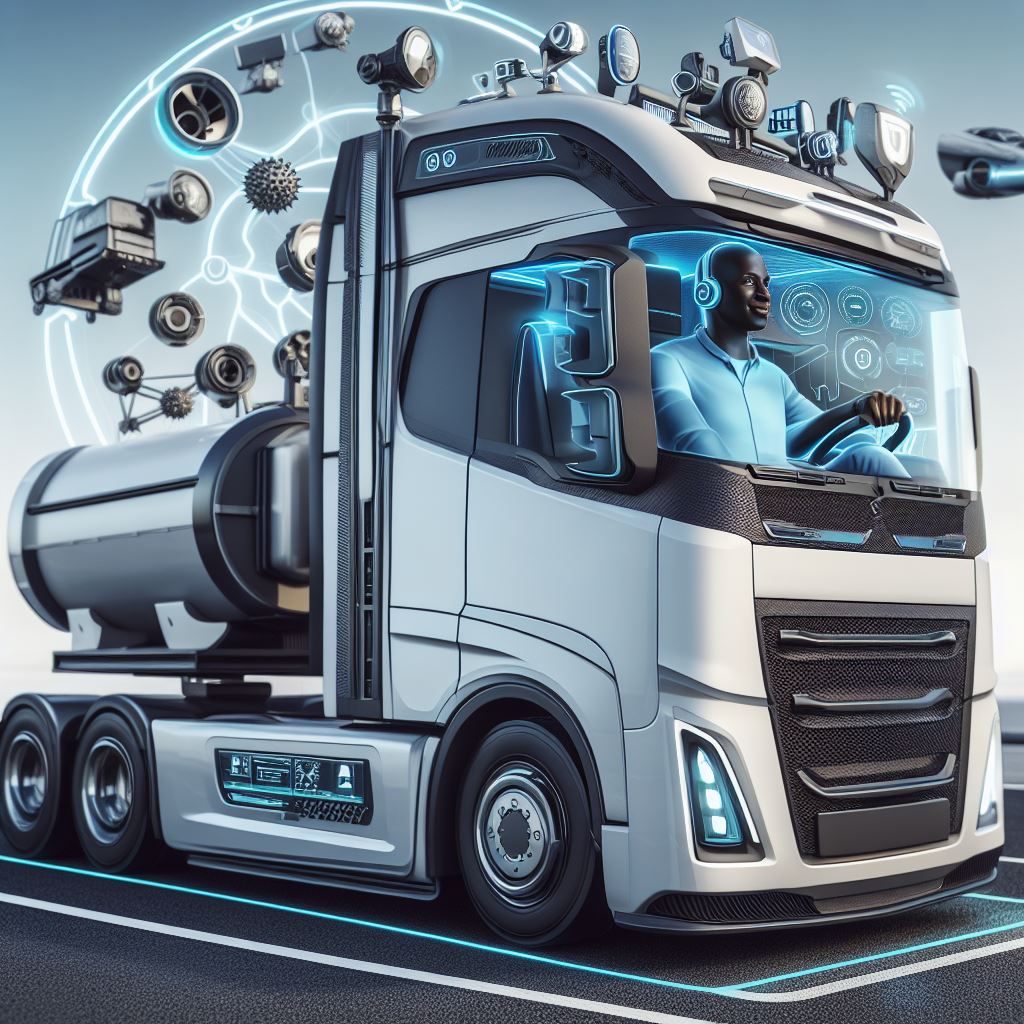Introduction
The impact of technology on US truck driving jobs has been a topic of increasing concern.
With advancements in automation and artificial intelligence, the future of truck driving is uncertain.
It is crucial to explore and understand the potential consequences of technology on this industry.
Brief overview of the topic
The trucking industry plays a vital role in the US economy, transporting goods across the country.
However, recent developments in technology have raised questions about the future of truck driving jobs.
With autonomous trucks being tested and online platforms for load booking gaining popularity, the industry is experiencing significant changes.
Importance of discussing the impact of technology on US truck driving jobs
Understanding the potential impact of technology on US truck driving jobs is crucial for various reasons.
Firstly, truck driving has long been a reliable source of employment and a route to middle-class stability for many Americans.
Any disruption caused by technology could have significant social and economic implications.
Moreover, the trucking industry is a major employer in the US, employing millions of people.
If technology were to replace human drivers, it would result in a massive loss of jobs, potentially leading to widespread unemployment and a strain on the nation’s economy.
Additionally, the trucking industry is an essential part of the supply chain, connecting manufacturers, distributors, and consumers.
Any disruption caused by technological advancements could affect the efficiency and reliability of moving goods, potentially leading to increased costs and delays.
In essence, given the significant impact of technology on US truck driving jobs, it is crucial to discuss and understand the potential consequences.
The potential loss of jobs and the impact on the economy and supply chain make this topic of utmost importance.
It is essential to find a balance that allows for technological advancements while also considering the welfare of truck drivers and the overall stability of the industry.
Overview of the Trucking Industry
- The trucking industry plays a vital role in transporting goods across the United States.
- It is a key component of the supply chain and contributes significantly to the economy.
- Truck drivers are responsible for delivering goods to various destinations efficiently and on time.
Importance and Role of Truck Drivers in the US Economy
- Truck drivers are the backbone of the US economy, ensuring that goods reach consumers promptly.
- They transport essential items such as food, medicine, and raw materials to support various industries.
- Without truck drivers, manufacturing, retail, and other sectors would face disruptions and economic losses.
Statistics on the Number of Truck Driving Jobs in the US:
- According to the American Trucking Associations, there are about 3.6 million truck drivers in the United States.
- Truck driving jobs account for around 5% of all jobs in the country, making it a significant employment sector.
- The demand for truck drivers has been steadily increasing, with an estimated shortage of over 60,000 drivers.
The trucking industry, transformed by technology, offers efficiency through GPS and online load boards, streamlining routes and tracking.
Automation, however, threatens truck drivers’ jobs, with companies like Tesla and Waymo testing self-driving trucks to cut costs and boost efficiency.
The potential widespread use of autonomous trucks raises concerns about unemployment and income inequality.
While fully autonomous trucks are not prevalent on US roads due to regulatory hurdles and safety concerns, the technology’s development continues.
Transform Your Career Today
Unlock a personalized career strategy that drives real results. Get tailored advice and a roadmap designed just for you.
Start NowHuman truck drivers excel in handling unexpected situations, managing logistics, and providing customer service.
To safeguard jobs, investing in the reskilling and upskilling of truck drivers is crucial, enabling adaptation to the evolving industry.
Policy collaboration is essential to navigate disruptions caused by automation.
Strategies for retraining, creating new job opportunities, and implementing regulations ensure a smooth transition to autonomous vehicles.
Proactive management of technology’s effects can minimize negative consequences, maximizing benefits for truck drivers and the economy.
In fact, the trucking industry’s role in the US economy is pivotal. While technology enhances efficiency, automation poses challenges to truck driving jobs.
Embracing advancements, reskilling drivers, and strategic planning for autonomous trucks can ensure a thriving industry that continues to support the economy.
Read: Understanding the Different Truck Driver License Types
Advancements in Technology
Technology is revolutionizing the world, and the trucking industry is not exempt from these advancements.
In recent years, several technologies have emerged that have the potential to significantly impact truck driving jobs.
Various technologies that have the potential to impact truck driving job
1. Autonomous Vehicles
- Self-driving trucks have gained traction, with companies like Tesla and Waymo leading the way.
- These vehicles have the potential to eliminate the need for human drivers, ultimately affecting employment opportunities.
- While the technology is still being perfected, the benefits include improved safety and increased efficiency.
2. Electric Trucks
- The rise of electric vehicles is transforming the trucking industry.
- Electric trucks are more environmentally friendly and have the potential to reduce operational costs.
- However, the adoption of electric trucks may require adjustments to infrastructure and charging stations.
3. Advanced Logistics Software
- New logistics software enables real-time tracking of shipments, optimizing routes, and reducing delivery times.
- This technology has the potential to improve efficiency by streamlining processes and increasing productivity.
- Additionally, it can minimize costs by reducing fuel consumption and avoiding delays caused by traffic or accidents.
4. Internet of Things (IoT) in Trucking
- The IoT allows for the connection and communication between various trucking components.
- Through sensors and data collection, trucking companies can monitor fuel efficiency, engine performance, and maintenance needs.
- This technology can lead to proactive maintenance, reducing downtime and improving overall fleet management.
Examples of Technological Advancements in the Trucking Industry
Several examples highlight how technology is already impacting the trucking industry:
- Platooning: This technology enables trucks to drive in close proximity, improving fuel efficiency.
- Collision Avoidance Systems: Truck manufacturers are incorporating sensors and cameras to prevent accidents.
- Electronic Logging Devices (ELDs): These devices track a driver’s hours of service, ensuring compliance with regulations.
The Benefits of Technological Advancements
These technological advancements can bring numerous benefits to the trucking industry:
- Improved Efficiency: Autonomous vehicles and advanced logistics software can optimize routes, reducing delivery times.
- Enhanced Safety: Collision avoidance systems and IoT technology can help prevent accidents and monitor driver behavior.
- Reduced Costs: Electric trucks and efficient logistics software can minimize fuel consumption and operational expenses.
However, it’s important to acknowledge the potential challenges that come with these advancements:
- Job Displacement: The emergence of autonomous vehicles may result in a decreased need for truck drivers.
- Infrastructure Requirements: Adopting electric trucks requires adequate charging infrastructure and widespread availability.
- Reliability and Security: The use of advanced technology raises concerns about system reliability and cybersecurity.
Therefore, technology is making waves in the trucking industry, bringing about significant changes and possibilities.
While advancements have the potential to enhance efficiency, safety, and reduce costs, they also pose challenges that need to be addressed.
It is crucial for the industry to adapt and embrace these advancements while also considering the well-being and future of truck driving jobs.
Read: Pros and Cons: Life as a Long-Haul Truck Driver

Potential Benefits of Technology on Truck Driving Jobs
Technology has made significant advancements that have revolutionized various industries, including the trucking industry.
With the introduction of advanced technology, truck driving jobs have greatly benefited in numerous ways.
Showcase Your Business Today
Reach thousands of readers actively exploring professional services. Publish your business profile and grow your audience now.
Publish NowIncreased safety measures for truck drivers
- Installation of advanced safety features in trucks, such as collision avoidance systems and blind-spot detection.
- Integration of technology-enabled driver assistance systems that provide real-time monitoring of driver behavior.
- Use of intelligent transportation systems to notify drivers of hazardous road conditions, reducing the risk of accidents.
- Implementation of telematics devices that track driver performance, ensuring adherence to safety regulations.
Reduction of driver fatigue and human error
- Introduction of fatigue monitoring systems that analyze driver behavior and alert them when they show signs of exhaustion.
- Automation of various tasks, such as automatic braking systems and lane departure warnings, reducing the chances of human error.
- Implementation of smart scheduling systems that ensure drivers get adequate rest periods to prevent fatigue-related accidents.
Enhanced transportation logistics and route planning
- Utilization of GPS technology that provides real-time traffic updates and alternative route suggestions, maximizing efficiency.
- Integration of advanced mapping systems that consider factors like road conditions, weather forecasts, and delivery deadlines.
- Optimization of load planning and route selection, resulting in improved delivery times and increased customer satisfaction.
Improved fuel efficiency and reduced emissions
- Adoption of hybrid and electric trucks that significantly reduce fuel consumption and greenhouse gas emissions.
- Implementation of eco-driving techniques facilitated by technology, such as engine efficiency monitoring and speed limit recommendations.
- Integration of aerodynamic designs and lightweight materials, reducing drag and enhancing fuel economy.
These advancements in technology have proven to be a game-changer for truck driving jobs.
By increasing safety measures, truck drivers can now operate in a safer environment, reducing the likelihood of accidents and injuries.
With the reduction of driver fatigue and human error, road safety is further improved, making transportation a more reliable and secure industry.
Furthermore, the enhanced transportation logistics and route planning systems have resulted in optimized delivery processes, allowing companies to meet tight deadlines and positively impacting customer satisfaction.
Additionally, the integration of technology has led to better fuel efficiency, resulting in cost savings for trucking companies and a significant reduction in harmful emissions, ultimately benefitting the environment.
In general, the impact of technology on US truck driving jobs has been overwhelmingly positive.
The improvements in safety measures, reduction of driver fatigue and human error, advancements in transportation logistics, and fuel efficiency have transformed the trucking industry for the better.
As technology continues to advance, it holds immense potential for further enhancements in the truck
driving profession.
Read: Essential Safety Tips Every Truck Driver Should Know
Potential Challenges Faced by Truck Drivers due to Technology
- Automation leading to job displacement.
- Truck drivers experiencing reduced demand as software and machines take over.
- Lack of job security due to the increasing use of autonomous vehicles.
- Impact of automation on truck driving wages.
- Impact on the trucking industry workforce.
- Need for retraining and upskilling in response to technological advancements
Technology transforms the trucking industry, enhancing efficiency and safety, yet posing challenges for drivers.
Automation, with its sophisticated software and machines, displaces jobs, reducing demand and opportunities.
This shift impacts wages as companies prioritize cost-cutting, intensifying competition and devaluing human labor.
The increasing use of autonomous vehicles diminishes the need for human drivers, raising concerns about layoffs and unemployment.
Losing experienced drivers to automation removes valuable expertise from the workforce.
Responding to these challenges requires retraining and upskilling in the industry, adapting to advanced technologies’ operation and maintenance.
The demand for tech-savvy individuals to manage and support these advancements is growing.
Despite undeniable benefits, the industry and drivers must navigate the challenges of job displacement, wage pressure, workforce impact, and the imperative for continuous adaptation to thrive in the face of technological advancements.
Future Outlook and Conclusion
Predictions for the truck driving industry’s future with the impact of technology are encouraging.
With advancements like autonomous vehicles and GPS systems, the industry is poised for significant transformation.
Adapting to technological changes is crucial for truck drivers to remain competitive in the field. Those who embrace new technologies and continuously upgrade their skills will have a better chance of job security.
However, it is vital for government and industry leaders to address the challenges and opportunities presented by these new technologies.
Regulations and policies must be updated to ensure the safety and efficiency of autonomous trucks.
Government and industry leaders must also address the concerns of job displacement.
While automation may eliminate certain truck driving jobs, it can create new opportunities in related fields, such as maintenance and monitoring of autonomous vehicles.
To tackle these issues, a call to action is necessary.
Government agencies and industry associations should collaborate to develop programs and initiatives that train truck drivers for jobs in the evolving technological landscape.
This will help to ensure a smooth transition and maintain a skilled workforce.
Furthermore, stakeholders need to invest in research and development to improve the technology itself. Innovations to enhance safety and efficiency should be a priority.
The truck driving industry is on the cusp of a technological revolution. While it may bring changes and challenges, there are also tremendous opportunities for growth.
By embracing new technologies, adapting to change, and working together, we can build a resilient and prosperous future for the truck driving industry.
[E-Books for Sale]
The Big Book of 500 High-Paying Jobs in America: Unlock Your Earning Potential
$19.99 • 500 High-Paying Jobs • 330 pages
Explore 500 high-paying jobs in America and learn how to boost your career, earn more, and achieve success!
See All 500 High-Paying Jobs of this E-Book
1001 Professions Without a Degree: High-Paying American Jobs You Can Start Now
$19.99 • 1001 Professions Without a Degree • 174 pages
Discover 1001 high-paying jobs without a degree! Unlock career tips, skills, and success strategies for just $19.99!




